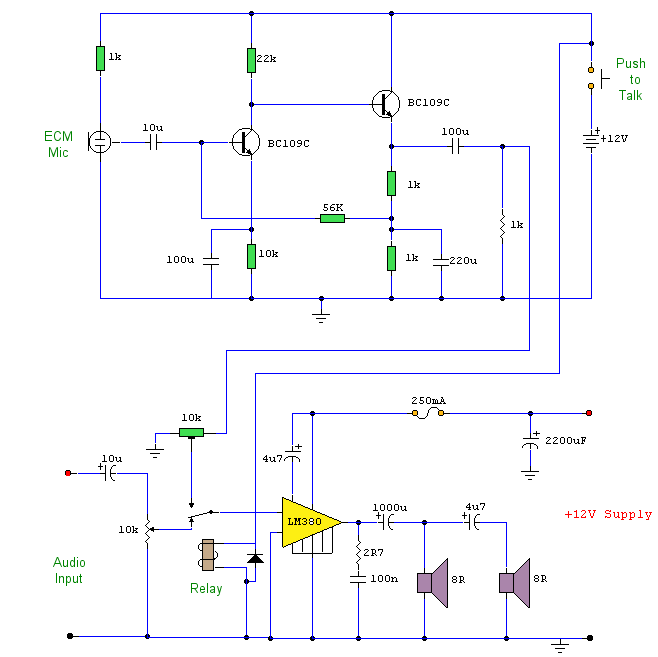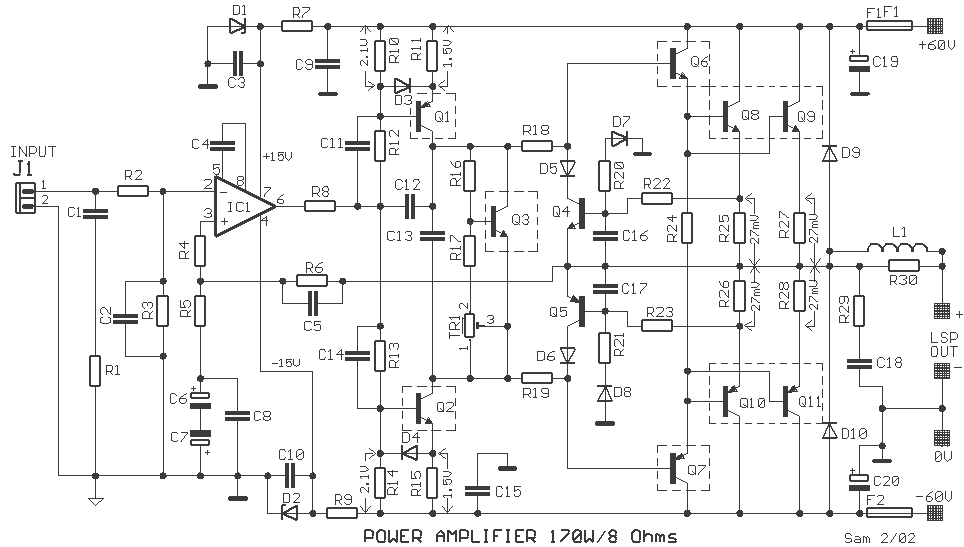
Audio Voice-Over Circuit PCB

This circuit features a microphone and preamplifier that take precedence over any other audio signal, functioning similarly to a one-way intercom. When the push-to-talk switch is activated, the main amplifier switches from music playback to the voice signal. Essentially, a voice-over unit comprises a microphone and a changeover switch that directs the amplifier's input, prioritizing the microphone output when the switch is engaged. The design includes a preamplifier positioned close to the microphone, allowing for operation at a distance from the main amplifier. The changeover switch is implemented using a relay with a single changeover contact. An amplifier circuit based on the LM380 is provided for reference. The remote microphone unit connects to the amplifier and switching unit using three wires. The schematic features two BC109C transistors configured as a microphone preamplifier, with the left transistor operating in common emitter mode and the right as an emitter follower. This arrangement yields a high-gain, low-output impedance amplifier capable of driving long audio cables. The output from the microphone preamplifier is designed to be low impedance, ensuring immunity to mains hum and background noise, and does not require screened cable. The input is represented as a three-wire Electret Condenser Microphone, although two-wire ECMs can also be utilized. The preamplifier output is coupled through a 100 µF capacitor and a 1 kΩ resistor, with the resistor serving to eliminate the DC component of the audio output. A cable with three or more wires connects to the remote amplifier. The amplifier, based on the National Semiconductor LM380, receives the input signal through the normally closed contact of a changeover relay, with a 10 kΩ potentiometer functioning as the volume control for the audio input. A 10 kΩ preset connected to the normally open contact allows for independent volume control of the voice input, bypassing the normal volume control. When the push-to-talk switch is pressed, the relay activates, allowing the voice signal to be heard through the speaker without any audible "thump" or "thud," as the DC component has been removed. This circuit is particularly suitable for applications in remote locations, such as workshops or sheds.
The circuit architecture is designed to facilitate effective communication in environments where background noise may be present. The use of the BC109C transistors for the preamplifier stage ensures that the microphone signal is amplified sufficiently while maintaining a low output impedance, which is crucial for long-distance audio transmission. The choice of the LM380 amplifier allows for robust audio amplification, making it suitable for driving speakers in various settings.
The relay-based changeover switch not only prioritizes the microphone input but also ensures seamless transitions between audio sources. The design is inherently simple, relying on widely available components, which enhances its practicality for DIY enthusiasts and professionals alike. The implementation of a potentiometer for volume control provides flexibility in adjusting the audio levels, catering to different user preferences.
In summary, this circuit serves as a reliable solution for audio communication, prioritizing voice signals over other audio inputs, and is well-suited for various applications where clear communication is essential.This is a circuit where a microphone and preamp circuit (voice circuit) have priority over any other audio signal. You can think of this as a one way intercom, if the main amplifier is used for listening to music, then when the push to talk switch is pressed, the amplifier is switched to the voice signal.
In its simplest form, a voice-over unit is just a microphone and change-over switch feeding an amplifier, the output from the microphone having priority over the amplifiers audio signal when the "push-to-talk" switch is pressed. In this circuit, a preamplifier immediately follows the microphone and is designed to be used some distance away from the main amplifier.
The changeover switch is nothing more than a relay with a single changeover contact. For completion, an amplifier based on the LM380 is shown. Three wires are needed to connect the remote microphone unit to the amplifier and switching unit. With reference to the above schematic, the two BC109C transistors are used to make a microphone preamplifier. The left hand BC109C operates in common emitter mode, the right hand emitter follower. The combination form a high gain, low output impedance amplifier, capable of driving a long audio cable.
Screened cable is not required as the output impedance from the microphone pre-amp is very low, and will be immune to mains hum and background noise. The input is shown as a three wire Electret Condenser Microphone though two wire ECM`s may also be used.
The output of the pre-amp is via a 100uF capacitor and 1k resistor. The 1k resistor here plays an important role, eliminating the dc component of the audio output. (See also eliminating the DC "thump" also on this web site. ) A cable of three or more wires is wired to the remote amplifier. The amplifier shown here is based on the National Semiconductor LM380. The input signal is passed via the normally closed contact of a changeover relay, the 10k potentiometer being the volume control for the audio input source. The 10k preset at the normally open contact allows volume control of the voice input, note that this signal has by-passed the normal volume control.
At the remote end, when the push-to-talk switch is pressed, the relay will operate and the "voice" signal will be heard in the speaker. There will be no "thump" or "thud" on voice-over as direct current has been eliminated as already mentioned.
A suitable application for this circuit would be for use in a remote location such as a workshop or shed. 🔗 External reference
The circuit architecture is designed to facilitate effective communication in environments where background noise may be present. The use of the BC109C transistors for the preamplifier stage ensures that the microphone signal is amplified sufficiently while maintaining a low output impedance, which is crucial for long-distance audio transmission. The choice of the LM380 amplifier allows for robust audio amplification, making it suitable for driving speakers in various settings.
The relay-based changeover switch not only prioritizes the microphone input but also ensures seamless transitions between audio sources. The design is inherently simple, relying on widely available components, which enhances its practicality for DIY enthusiasts and professionals alike. The implementation of a potentiometer for volume control provides flexibility in adjusting the audio levels, catering to different user preferences.
In summary, this circuit serves as a reliable solution for audio communication, prioritizing voice signals over other audio inputs, and is well-suited for various applications where clear communication is essential.This is a circuit where a microphone and preamp circuit (voice circuit) have priority over any other audio signal. You can think of this as a one way intercom, if the main amplifier is used for listening to music, then when the push to talk switch is pressed, the amplifier is switched to the voice signal.
In its simplest form, a voice-over unit is just a microphone and change-over switch feeding an amplifier, the output from the microphone having priority over the amplifiers audio signal when the "push-to-talk" switch is pressed. In this circuit, a preamplifier immediately follows the microphone and is designed to be used some distance away from the main amplifier.
The changeover switch is nothing more than a relay with a single changeover contact. For completion, an amplifier based on the LM380 is shown. Three wires are needed to connect the remote microphone unit to the amplifier and switching unit. With reference to the above schematic, the two BC109C transistors are used to make a microphone preamplifier. The left hand BC109C operates in common emitter mode, the right hand emitter follower. The combination form a high gain, low output impedance amplifier, capable of driving a long audio cable.
Screened cable is not required as the output impedance from the microphone pre-amp is very low, and will be immune to mains hum and background noise. The input is shown as a three wire Electret Condenser Microphone though two wire ECM`s may also be used.
The output of the pre-amp is via a 100uF capacitor and 1k resistor. The 1k resistor here plays an important role, eliminating the dc component of the audio output. (See also eliminating the DC "thump" also on this web site. ) A cable of three or more wires is wired to the remote amplifier. The amplifier shown here is based on the National Semiconductor LM380. The input signal is passed via the normally closed contact of a changeover relay, the 10k potentiometer being the volume control for the audio input source. The 10k preset at the normally open contact allows volume control of the voice input, note that this signal has by-passed the normal volume control.
At the remote end, when the push-to-talk switch is pressed, the relay will operate and the "voice" signal will be heard in the speaker. There will be no "thump" or "thud" on voice-over as direct current has been eliminated as already mentioned.
A suitable application for this circuit would be for use in a remote location such as a workshop or shed. 🔗 External reference





